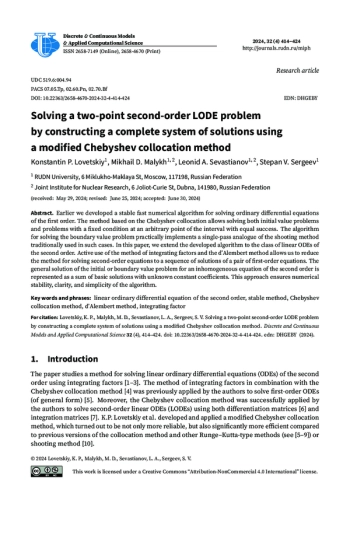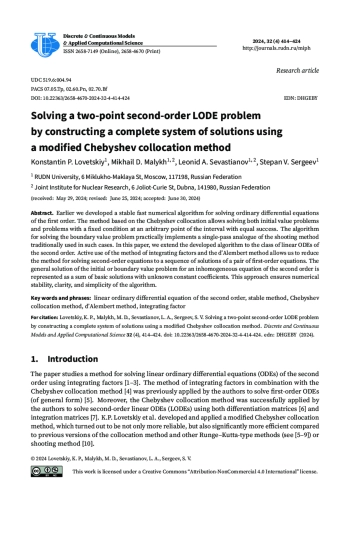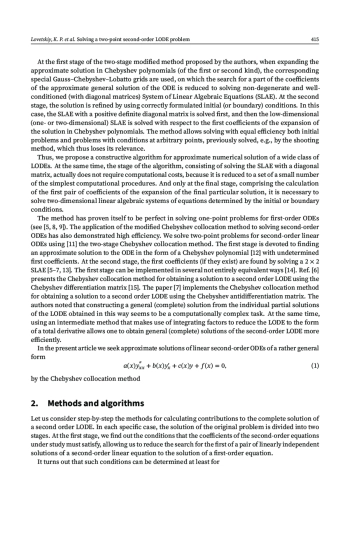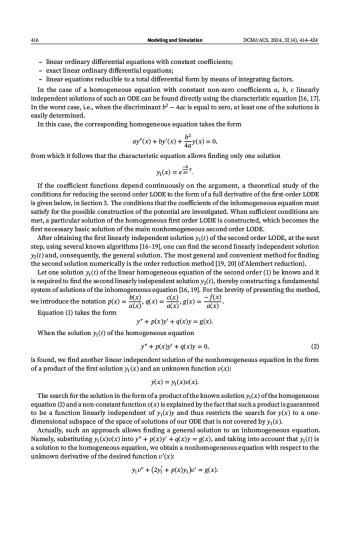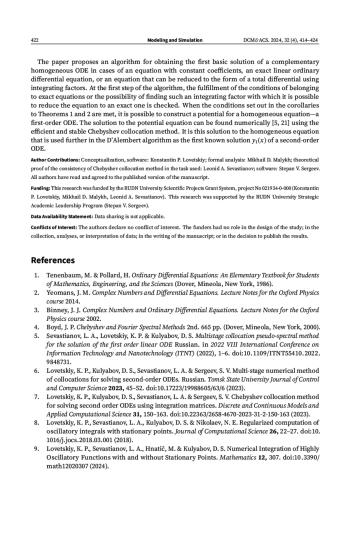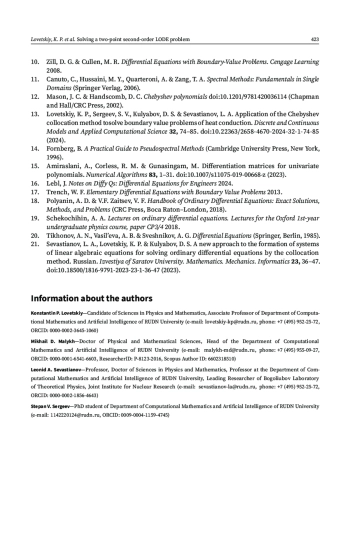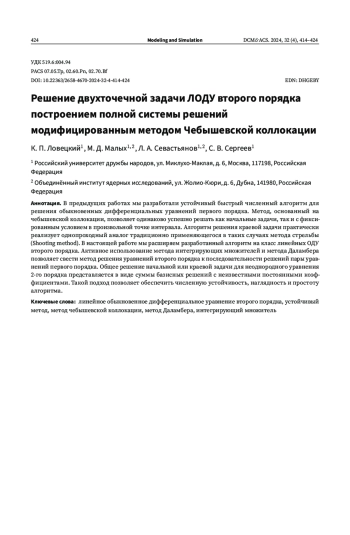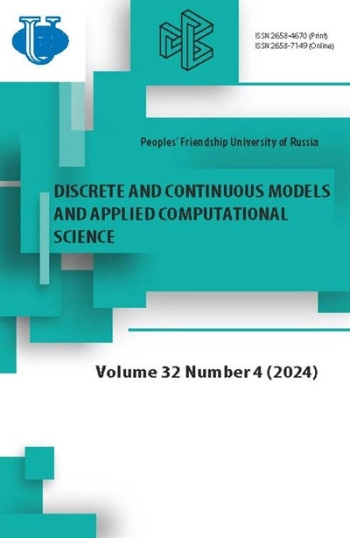Earlier we developed a stable fast numerical algorithm for solving ordinary differential equations of the first order. The method based on the Chebyshev collocation allows solving both initial value problems and problems with a fixed condition at an arbitrary point of the interval with equal success. The algorithm for solving the boundary value problem practically implements a single-pass analogue of the shooting method traditionally used in such cases. In this paper, we extend the developed algorithm to the class of linear ODEs of the second order. Active use of the method of integrating factors and the d’Alembert method allows us to reduce the method for solving second-order equations to a sequence of solutions of a pair of first-order equations. The general solution of the initial or boundary value problem for an inhomogeneous equation of the second order is represented as a sum of basic solutions with unknown constant coefficients. This approach ensures numerical stability, clarity, and simplicity of the algorithm.
Идентификаторы и классификаторы
The paper studies a method for solving linear ordinary differential equations (ODEs) of the second order using integrating factors [1–3]. The method of integrating factors in combination with the Chebyshev collocation method [4] was previously applied by the authors to solve first-order ODEs (of general form) [5]. Moreover, the Chebyshev collocation method was successfully applied by the authors to solve second-order linear ODEs (LODEs) using both differentiation matrices [6] and integration matrices [7]. K. P. Lovetskiy et al. developed and applied a modified Chebyshev collocation method, which turned out to be not only more reliable, but also significantly more efficient compared to previous versions of the collocation method and other Runge–Kutta-type methods (see [5–9]) or shooting method [10].
Список литературы
1. Tenenbaum, M. & Pollard, H. Ordinary Differential Equations: An Elementary Textbook for Students of Mathematics, Engineering, and the Sciences (Dover, Mineola, New York, 1986).
2. Yeomans, J. M. Complex Numbers and Differential Equations. Lecture Notes for the Oxford Physics course 2014.
3. Binney, J. J. Complex Numbers and Ordinary Differential Equations. Lecture Notes for the Oxford Physics course 2002.
4. Boyd, J. P. Chebyshev and Fourier Spectral Methods 2nd. 665 pp. (Dover, Mineola, New York, 2000).
5. Sevastianov, L. A., Lovetskiy, K. P. & Kulyabov, D. S. Multistage collocation pseudo-spectral method for the solution of the first order linear ODE Russian. in 2022 VIII International Conference on Information Technology and Nanotechnology (ITNT) (2022), 1–6. doi:10.1109/ITNT55410.2022. 9848731.
6. Lovetskiy, K. P., Kulyabov, D. S., Sevastianov, L. A. & Sergeev, S. V. Multi-stage numerical method of collocations for solving second-order ODEs. Russian. Tomsk State University Journal of Control and Computer Science 2023, 45–52. doi:10.17223/19988605/63/6 (2023).
7. Lovetskiy, K. P., Kulyabov, D. S., Sevastianov, L. A. & Sergeev, S. V. Chebyshev collocation method for solving second order ODEs using integration matrices. Discrete and Continuous Models and Applied Computational Science 31, 150–163. doi:10.22363/2658-4670-2023-31-2-150-163 (2023).
8. Lovetskiy, K. P., Sevastianov, L. A., Kulyabov, D. S. & Nikolaev, N. E. Regularized computation of oscillatory integrals with stationary points. Journal of Computational Science 26, 22–27. doi:10. 1016/j.jocs.2018.03.001 (2018).
9. Lovetskiy, K. P., Sevastianov, L. A., Hnatič, M. & Kulyabov, D. S. Numerical Integration of Highly Oscillatory Functions with and without Stationary Points. Mathematics 12, 307. doi:10.3390/ math12020307 (2024).
10. Zill, D. G. & Cullen, M. R. Differential Equations with Boundary-Value Problems. Cengage Learning 2008.
11. Canuto, C., Hussaini, M. Y., Quarteroni, A. & Zang, T. A. Spectral Methods: Fundamentals in Single Domains (Springer Verlag, 2006).
12. Mason, J. C. & Handscomb, D. C. Chebyshev polynomials doi:10.1201/9781420036114 (Chapman and Hall/CRC Press, 2002).
13. Lovetskiy, K. P., Sergeev, S. V., Kulyabov, D. S. & Sevastianov, L. A. Application of the Chebyshev collocation method tosolve boundary value problems of heat conduction. Discrete and Continuous Models and Applied Computational Science 32, 74–85. doi:10.22363/2658-4670-2024-32-1-74-85 (2024).
14. Fornberg, B. A Practical Guide to Pseudospectral Methods (Cambridge University Press, New York, 1996).
15. Amiraslani, A., Corless, R. M. & Gunasingam, M. Differentiation matrices for univariate polynomials. Numerical Algorithms 83, 1–31. doi:10.1007/s11075-019-00668-z (2023).
16. Lebl, J. Notes on Diffy Qs: Differential Equations for Engineers 2024.
17. Trench, W. F. Elementary Differential Equations with Boundary Value Problems 2013.
18. Polyanin, A. D. & V.F. Zaitsev, V. F. Handbook of Ordinary Differential Equations: Exact Solutions, Methods, and Problems (CRC Press, Boca Raton–London, 2018).
19. Schekochihin, A. A. Lectures on ordinary differential equations. Lectures for the Oxford 1st-year undergraduate physics course, paper CP3/4 2018.
20. Tikhonov, A. N., Vasil’eva, A. B. & Sveshnikov, A. G. Differential Equations (Springer, Berlin, 1985).
21. Sevastianov, L. A., Lovetskiy, K. P. & Kulyabov, D. S. A new approach to the formation of systems of linear algebraic equations for solving ordinary differential equations by the collocation method. Russian. Izvestiya of Saratov University. Mathematics. Mechanics. Informatics 23, 36–47. doi:10.18500/1816-9791-2023-23-1-36-47 (2023).
Выпуск
Другие статьи выпуска
Superconducting properties of twisted tri-layer graphene (TTG) are studied within the scope of the chiral model based on using the unitary matrix
In this article, we propose fourth- and fifth-order two-step iterative methods for solving the systems of nonlinear equations in
The problem of summation of Fourier series in finite form is formulated in the weak sense, which allows one to consider this problem uniformly both for classically convergent and for divergent series. For series with polynomial Fourier coefficients
Various approaches to calculating normal modes of a closed waveguide are considered. A review of the literature was given, a comparison of the two formulations of this problem was made. It is shown that using a self-adjoint formulation of the problem of normal waveguide modes eliminates the occurrence of artifacts associated with the appearance of a small imaginary additive to the eigenvalues. The implementation of this approach for a rectangular waveguide with rectangular inserts in the Sage computer algebra system is presented and tested on hybrid modes of layered waveguides. The tests showed that our program copes well with calculating the points of the dispersion curve corresponding to the hybrid modes of the waveguide.
The paper considers a single-line retrial queueing system with an unreliable server. Queuing systems are called unreliable if their servers may fail from time to time and require restoration (repair), only after which they can resume servicing customers. The input of the system is a simple Poisson flow of customers. The service time and uptime of the server are distributed exponentially. An incoming customer try to get service. The server can be free, busy or under repair. The customer is serviced immediately if the server is free. If it is busy or under repair, the customer goes into orbit. And after a random time it tries to get service again. The study is carried out by the method of asymptotically diffusion analysis under the condition of a large delay of requests in orbit. In this work, the transfer coefficient and diffusion coefficient were found and a diffusion approximation was constructed.
The paper presents a new multimodal approach to analyzing the psycho-emotional state of a person using nonlinear classifiers. The main modalities are the subject’s speech data and video data of facial expressions. Speech is digitized and transcribed using the Scribe library, and then mood cues are extracted using the Titanis sentiment analyzer from the FRC CSC RAS. For visual analysis, two different approaches were implemented: a pre-trained ResNet model for direct sentiment classification from facial expressions, and a deep learning model that integrates ResNet with a graph-based deep neural network for facial recognition. Both approaches have faced challenges related to environmental factors affecting the stability of results. The second approach demonstrated greater flexibility with adjustable classification vocabularies, which facilitated post-deployment calibration. Integration of text and visual data has significantly improved the accuracy and reliability of the analysis of a person’s psycho-emotional state
Integrated Access and Backhaul (IAB) technology facilitates the establishment of a compact network by utilizing repeater nodes rather than fully equipped base stations, which subsequently minimizes the expenses associated with the transition towards next-generation networks. The majority of studies focusing on IAB networks rely on simulation tools and the creation of discrete-time models. This paper introduces a mathematical model for the boundary node in an IAB network functioning in half-duplex mode. The proposed model is structured as a polling service system with a dual-queue setup, represented as a random process in continuous time, and is examined through the lens of queueing theory, integral transforms, and generating functions (GF). As a result, analytical expressions were obtained for the GF, marginal distribution, as well as the mean and variance of the number of requests in the queues, which correspond to packets pending transmission by the relay node via access and backhaul channels.
We describe introduced in the journal the rubric system. We describe the general structure of an IMRAD research publication. The IMRAD structure for a research article is described in detail.
Статистика статьи
Статистика просмотров за 2025 год.
Издательство
- Издательство
- РУДН
- Регион
- Россия, Москва
- Почтовый адрес
- 117198, г. Москва, ул. Миклухо-Маклая, д. 6
- Юр. адрес
- 117198, г Москва, Обручевский р-н, ул Миклухо-Маклая, д 6
- ФИО
- Ястребов Олег Александрович (РЕКТОР)
- E-mail адрес
- rector@rudn.ru
- Контактный телефон
- +7 (495) 4347027
- Сайт
- https://www.rudn.ru/
